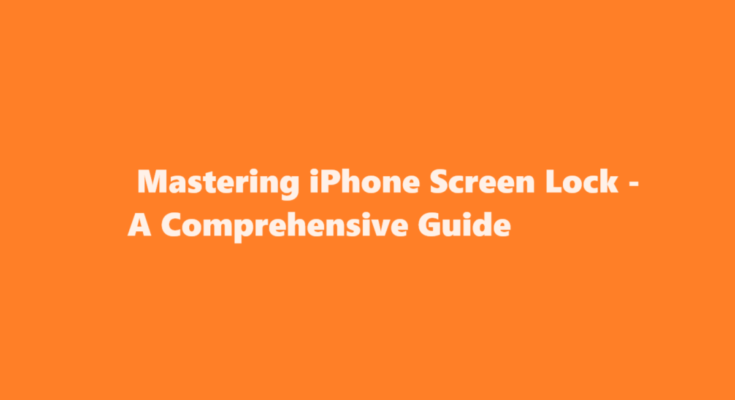Introduction
In today’s digital age, our smartphones, particularly the iPhone, have become an indispensable part of our lives, storing an abundance of personal and sensitive information. It’s crucial to ensure that your iPhone remains secure, and one of the fundamental steps in achieving this is learning how to lock your iPhone screen effectively. This article will guide you through the various methods to lock your iPhone screen and offer tips on enhancing your device’s security.
Why Locking Your iPhone Screen is Important
Locking your iPhone screen is essential for a variety of reasons
1. Privacy Protection: Locking your screen keeps your personal data, messages, emails, and photos private, preventing unauthorized access to your device.
2. Data Security: It safeguards your iPhone against unauthorized access in case it is lost or stolen, reducing the risk of data breaches.
3. Prevent Unauthorized Purchases: Locking your iPhone screen can prevent accidental or unauthorized app purchases and in-app transactions.
4. Enhanced Security: Different locking methods provide varying levels of security, enabling you to choose the one that suits your needs.
Methods to Lock Your iPhone Screen
Passcode Lock
One of the most basic and widely-used methods to lock your iPhone screen is by setting a passcode. Here’s how to do it
a. Go to “Settings” on your iPhone.
b. Scroll down and tap “Face ID & Passcode” (or “Touch ID & Passcode” on older iPhones).
c. Enter your current passcode if you already have one or create a new one.
You can choose between a 4-digit or 6-digit passcode, or even a custom alphanumeric code. Additionally, you can enable “Erase Data” to have your iPhone erase all data after ten unsuccessful password attempts, providing extra security.
Face ID and Touch ID
If you have an iPhone with Face ID (like iPhone X and later) or Touch ID (iPhone 5S to iPhone 8), you can use biometric authentication to lock your screen.
For Face ID
a. Go to “Settings” and tap “Face ID & Passcode.”
b. Set up a Face ID if you haven’t already.
c. Enable “Require Attention for Face ID” to enhance security.
For Touch ID
a. Go to “Settings” and tap “Touch ID & Passcode.”
b. Enroll your fingerprints in the system.
c. Enable “iPhone Unlock” to use Touch ID for screen lock.
Auto-Lock Feature
The Auto-Lock feature allows you to set a time limit for your iPhone’s screen to automatically lock when not in use. To configure this
a. Navigate to “Settings.”
b. Scroll down and tap “Display & Brightness.”
c. Choose “Auto-Lock” and select your preferred time limit (ranging from 30 seconds to 5 minutes).
This method is convenient and helps conserve battery life.
Emergency SOS
In emergency situations, you can quickly lock your iPhone screen by pressing the side button and volume down button simultaneously. This activates the Emergency SOS mode and temporarily disables Face ID or Touch ID.
Tips for Enhanced iPhone Screen Lock Security
1. Use Strong Passwords: Opt for a complex, alphanumeric passcode to enhance security, and avoid easily guessable options like “1234.”
2. Enable Erase Data: If you’re concerned about data security, enable the “Erase Data” feature to protect your information from unauthorized access.
3. Regularly Update Your iPhone: Keep your device up to date with the latest software updates to benefit from improved security features and patches.
4. Use Two-Factor Authentication: Enable two-factor authentication for your Apple ID to add an extra layer of protection to your account.
5. Implement Find My iPhone: In case your device is lost or stolen, you can use the Find My iPhone feature to remotely lock or erase your iPhone.
6. Be Cautious with Biometrics: While Face ID and Touch ID are convenient, they can be less secure if someone gains physical access to your face or fingerprints.
7. Enable ‘Require Attention’: For Face ID, enabling “Require Attention” ensures that your eyes are open when unlocking the phone, preventing unauthorized access.
FREQUENTLY ASKED QUESTIONS
What is the shortcut for lock screen?
Windows users can press Ctrl+Alt+Del and choose Lock from the list of options. You can also press the Windows key+L to lock your screen.
Can iPhone Lock Screen stay on?
On iPhone 14 Pro, iPhone 14 Pro Max, iPhone 15 Pro, and iPhone 15 Pro Max, the Always-On display setting allows a dimmed version of your Lock Screen to stay visible, even when your iPhone is locked.
Conclusion
Locking your iPhone screen is a fundamental step in safeguarding your personal information and ensuring the security of your device. With various methods at your disposal, such as passcodes, biometric authentication, and auto-lock settings, you have the flexibility to choose the level of security that best suits your needs. Additionally, following the security tips provided will further enhance your iPhone’s security, allowing you to use your device with peace of mind in an increasingly interconnected world.
Read Also : How to Program Your Spectrum Remote to Your TV



